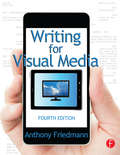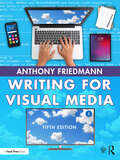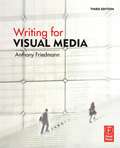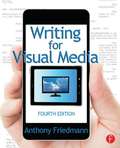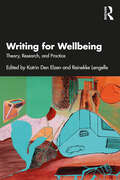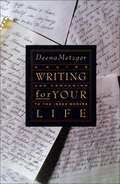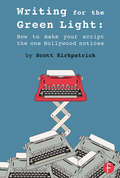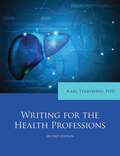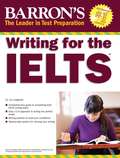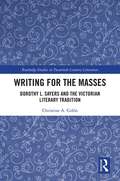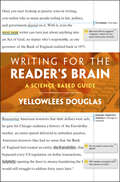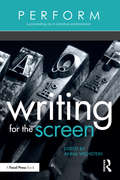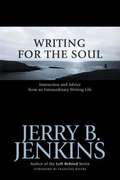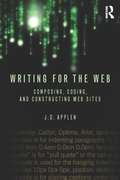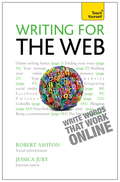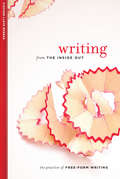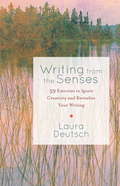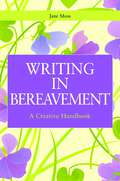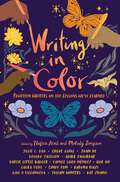- Table View
- List View
Writing for Visual Media
by Anthony FriedmannThis updated edition of Writing for Visual Media will enable you to understand the nature of visual writing that lies behind the content of all visual media. This unique kind of writing must communicate to audiences through content producers, since audiences don't read the script. Most media content provides a solution to a communication problem, which the writer must learn to analyze and solve before writing the script. The Fourth Edition strengthens the method for creating content and writing in the correct language and established format for each visual medium, including commercial communication such as ads and PSAs, corporate communications, and training. An extended investigation into dramatic theory and how entertainment narrative works is illustrated by examples and detailed analysis of scenes, scripts and storylines, saving you designed to save writers from typical pitfalls and releasing your creative powers of invention. Writing for Visual Media will help you to develop an improved foundation for understanding interactive media and writing for non-linear content, while gaining the tools to effectively connect with your audience like a professional. Purchase of this book includes access to the companion website, which provides: Sample scripts and video clips of those produced scripts An interactive glossary of camera shots, movements, and transitions Storyboards, scripts, screenplays, and links to industry resource Instructor materials such as PowerPoint lecture slides, a sample syllabus, and a test bank. Visit the site at www.routledgetextbooks.com/textbooks/9780415815857
Writing for Visual Media
by Anthony FriedmannWriting for Visual Media provides writers with an understanding of the nature of visual writing behind all visual media. Such writing is vital for directors, actors, and producers to communicate content to audiences. Friedmann provides an extended investigation into dramatic theory and how entertainment narrative works, illustrated by examples and detailed analysis of scenes, scripts, techniques, and storylines. This new edition has a finger on the pulse of the rapidly evolving media ecosystem and explains it in the context of writing and creating content. Friedmann lays out many of the complex professional, creative, and commercial issues that a writer needs to understand in order to tell engaging stories and construct effective and professional screenplays. This new edition includes: A new chapter on storytelling A fresh examination of dramatic theory and how to apply it to constructing screenplays Updated discussion of mobile platforms A lengthened discussion of copyright, ethics, and professional development issues An updated companion website with sample scripts and corresponding videos, an interactive glossary, sample storyboards and screenplays, links to industry resources, and materials for instructors such as slides, a syllabus, and a test bank.
Writing for Visual Media (3rd Edition)
by Anthony FriedmannWriting for Visual Media looks at the fundamental problems a writer faces in learning to create content for media that is to be seen rather than read. It takes you from basic concepts to practice through a seven-step method that helps you identify a communications problem, think it through, and find a resolution before beginning to write. Through successive exercises, Writing for Visual Mediahelps you acquire the basic skills and confidence you need to write effective films, corporate and training videos, documentaries, web sites, PSAs, TV shows, nonlinear media, and other types of visual narratives. You'll explore your visual imagination and try out your powers of invention. The companion web site enriches the content of the printed book with video, audio, and sample scripts. It includes scripts and the video produced from them; visual demonstrations of concepts; and an interactive, illustrated glossary of terms and concepts.
Writing for Visual Media (Fourth Edition)
by Anthony FriedmannThis updated edition of Writing for Visual Media will enable you to understand the nature of visual writing that lies behind the content of all visual media. This unique kind of writing must communicate to audiences through content producers, since audiences don't read the script. Most media content provides a solution to a communication problem, which the writer must learn to analyze and solve before writing the script. The new edition strengthens the method for creating content and writing in the correct language and established format for each visual medium, including commercial communication such as ads and PSAs, corporate communications, and training. An extended investigation into dramatic theory and how entertainment narrative works is illustrated by examples and detailed analysis of scenes, scripts and storylines, saving you designed to save writers from typical pitfalls and releasing your creative powers of invention. Writing for Visual Media will help you to develop an improved foundation for understanding interactive media and writing for non-linear content, while gaining the tools to effectively connect with your audience like a professional. Purchase of this book includes access to the companion website, www. focalpress. com/cw/friedmann (coming June 5), which provides: Sample scripts and video clips of those produced scripts An interactive glossary of camera shots, movements, and transitions Storyboards, scripts, screenplays, and links to industry resource Instructor materials such as PowerPoint lecture slides, a sample syllabus, and a test bank.
Writing for Wellbeing: Theory, Research, and Practice
by Reinekke Lengelle Katrin Den ElzenWriting can support our wellbeing even under the most difficult life circumstances, helping us to adapt to significant change, make sense of loss, improve our physical and emotional resilience, and foster personal growth. Numerous studies of Expressive Writing have confirmed this, and there are other established methodologies for practice. However, to date, few accounts have offered detailed descriptions showing how and why putting pen to paper can be so beneficial. This book delves deeply into the landscape of Writing-for-wellbeing and demonstrates the transformative power of writing in a wide range of contexts. Topics include personal trauma narratives within the Humanities; a participatory Writing-for-wellbeing study that demonstrates the effectiveness of writing in the context of grief and loss; surprise as the hidden mainspring of poetry's therapeutic potency; the empowerment and healing potential offered by Black women’s blogs; playwriting positioning LGBTQIA+ identities as positive through stories of belonging; how writing workshops have helped newly literate Indigenous adults and other participants in the Australian outback; and how the smuggled writings of Behrouz Boochani have enabled global witnessing of the stories of refugees held in offshore detention. This resource sets out the theory and research at the foundation of Writing-for-wellbeing in close relation to full and engaging accounts of practice. It aims to make the topic accessible and affirms its place as an effective reconstructive practice alongside other expressive arts therapies, providing a holistic and inspiring resource for anyone wishing to practice, teach, or research Writing-for-wellbeing.
Writing for Your Life: A Guide and Companion to the Inner Worlds
by Deena MetzgerA poet and therapist helps readers access the healing power of writing in this inspiring guide to creative self-reflection.In Writing for Your Life, Deena Metzger gives readers the tools to experience the wonder of self-knowledge and the joy of creation, while healing what is fragmented, injured, or suppressed within us. In this resource for writers and nonwriters alike, Metzger helps us explore ourselves and our creativity through journals, autobiography, stories, fairy tales, dreams, and myths. She offers stories and suggests numerous exercises to show readers how writing shapes and informs our lives, and how our “silence” hinders us.
Writing for the Green Light: How to Make Your Script the One Hollywood Notices
by Scott KirkpatrickTailor your screenplay to sell. Find out what Hollywood script readers, producers, and studio executives want in a screenplay (and why) from someone who’s been there. Discover what it takes to begin a lasting career as a screenwriter. Peppered with interviews from established professionals, Writing for the Green Light: How to Make Your Script the One Hollywood Notices gives you a sharp competitive edge by showcasing dozens of everyday events that go on at the studios but are rarely if ever discussed in most screenwriting books. With his behind-the-scenes perspective, Scott Kirkpatrick shows you why the system works the way it does and how you can use its unwritten rules to your advantage. He answers such questions as: Who actually reads your script? How do you pique the interest of studios and decision makers? What do agents, producers, and production companies need in a script? How much is a script worth? What are the best genres for new writers and why? What are real steps you can take to ‘break in’ to television writing? How do you best present or pitch a project without looking desparate? How do you negotiate a contract without an agent? How do you exude confidence and seal your first deal? These and other insights are sure to give you and your screenplay a leg-up for success in this competitive landscape!
Writing for the Health Professions
by Karl TerryberryWriting for the Health Professions (updated second edition) is an ideal companion for students in allied health programs, and a valuable reference guide for health professionals. This book teaches the principles of writing for the health professions and guides the reader through the fundamentals of writing essays, professional papers, documentation and research grants. This book can be used in a variety of ways, including in writing class for health care students, a reference text for students during their academic years, or as a resource guide for the practicing professional. Writing for the Health Professions assumes the reader has a working knowledge of basic language skills and builds on those skills with a functional approach to grammar, usage and style for medical-related topics and issues directly related to the professional health services environment. Throughout the book every chapter includes a variety of exercises and examples to promote student engagement and learning about writing for the health professions.
Writing for the IELTS
by Lin LougheedDiscover everything you’ll need to know in order to write well for the IELTS test, whether you are planning to take the Academic or the General Training version. This book will help IELTS test takers learn several essential skills, including:Task Achievement: follow a three-step model to plan, write, and revise your essaysCoherence and Cohesion: practice organizing your writing and connecting ideasLexical Resource: build your vocabulary and use it correctlyGrammatical Range and Accuracy: review rules and practice applying them to your writingEach section leads you step-by-step through the process of writing an essay in response to a particular task. Learn how to apply what you’ve learned, familiarize yourself with the types of questions you’ll have to respond to on the test, complete your responses within the time limits, and more. An Appendix also includes a More Writing Practice section with a selection of essays written in response to IELTS writing tasks.
Writing for the Masses: Dorothy L. Sayers and the Victorian Literary Tradition (Routledge Studies in Twentieth-Century Literature)
by Christine ColónIn Writing for the Masses: Dorothy L. Sayers and the Victorian Literary Tradition Dr. Christine A. Colón explores how Sayers carefully negotiates the complexities of early twentieth century literary culture by embracing a specifically Victorian literary tradition of writing to engage a wide audience. Using a variety of examples from Sayers’s detective fiction, essays, and religious drama, Dr. Colón charts Sayers’s development as a writer whose intense desire to connect with her audience eventually compels her to embrace the role of a Victorian sage for her own age. Ultimately, the Victorian literary tradition not only provides her with an empowering model for her own work as she struggles as a writer of detective fiction to balance her integrity as an artist with her desire to reach a mass audience but also facilitates her growth as a public intellectual as she strives to help her nation recover from the devastation of World War II.
Writing for the Media: Film, Television, Video and Radio
by Paul Max Rubenstein Martin J. MaloneyThe business of writing fiction and non-fiction scripts, forms and formats, the story structure, writing dialogue, and information on selling your script. This is the second edition of the book.
Writing for the Reader's Brain: A Science-Based Guide
by Yellowlees DouglasWhat makes one sentence easy to read and another a slog that demands re-reading? Where do you put information you want readers to recall? What about details you need to reveal but want readers to forget? Drawing on cognitive neuroscience, psychology and psycholinguistics, this book provides a practical, how-to guide on how to write for your reader. It introduces the five 'Cs' of writing – clarity, continuity, coherence, concision, and cadence – and demonstrates how to use these to bring your writing to life. It also shows you how to do all this whilst also making the writing process speedier and more efficient. Brimming with examples, this humorous, surprisingly irreverent book provides writers with the tools they need to master everything from an email to a research project. If you believe good writers are simply born that way, Writing for the Reader's Brain will change your mind – and, quite possibly, your life.
Writing for the Screen (PERFORM)
by Anna WeinsteinWriting for the Screen is a collection of essays and interviews exploring the business of screenwriting. This highly accessible guide to working in film and television includes perspectives from industry insiders on topics such as breaking in; pitching; developing and nurturing business relationships; juggling multiple projects; and more. Writing for the Screen is an ideal companion to screenwriting and filmmaking classes, demystifying the industry and the role of the screenwriter with real-world narratives and little-known truths about the business. With insight from working professionals, you’ll be armed with the information you need to pursue your career as a screenwriter. Contains essays by and interviews with screenwriting consultants, television writers, feature writers, writer-directors of independent film, producers, and professors. Offers expert opinions on how to get started, including preparing your elevator pitch, finding mentors, landing an internship, and moving from an internship to the next step in your career. Reveals details about taking meetings, what development executives are looking for in a screenwriter, how and when to approach a producer, and how to pitch. Explores strategies for doing creative work under pressure, finding your voice, choosing what to write, sticking with a project over the long haul, overcoming discrimination, and reinventing yourself as a writer. Illuminates the business of screenwriting in the United States (New York and Los Angeles) as compared to other countries around the globe, including England, Ireland, Peru, France, Australia, and Belgium.
Writing for the Soul: Instruction and Advice from an Extraordinary Writing Life
by Jerry B. JenkinsJerry B. Jenkins is the author of the best-selling Left Behind series. This book will appeal to writers as well as fans of Jenkins' writing, as it taps into the growing Christian book industry. From learning the fundamental lessons of the writing world, to breaking in with small (even non-paying markets), Jenkins walks readers through the skills and abilities required to build a writing career. Filled with autobiographical tidbits and lessons he's learned along the way, Jenkins' Writing for the Soul will empower and entertain writers and readers everywhere.
Writing for the Web: Composing, Coding, and Constructing Web Sites
by J. D. ApplenWriting for the Web unites theory, technology, and practice to explore writing and hypertext for website creation. It integrates such key topics as XHTML/CSS coding, writing (prose) for the Web, the rhetorical needs of the audience, theories of hypertext, usability and architecture, and the basics of web site design and technology. Presenting information in digestible parts, this text enables students to write and construct realistic and manageable Web sites with a strong theoretical understanding of how online texts communicate to audiences. Key features of the book include: Screenshots of contemporary Web sites that will allow students to understand how writing for and linking to other layers of a Web site should work. Flow charts that describe how Web site architecture and navigation works. Parsing exercises in which students break down information into subsets to demonstrate how Web site architecture can be usable and scalable. Detailed step-by-step descriptions of how to use basic technologies such as file transfer protocols (FTP). Hands-on projects for students to engage in that allow them to connect the various components in the text. A companion website with downloadable code and additional pedagogical features: www.routledge.com/cw/applen ? Writing for the Web prepares students to work in professional roles, as it facilitates understanding of architecture and arrangement of written content of an organization’s texts.
Writing for the Web: Teach Yourself
by Robert Ashton Jessica JubyLike it or not, the internet has become integral to every aspect of our lives, with smart phones, tablet computers and wifi enabling us to communicate easily and instantly.Whether you're a rising star in the corporate world or a silver surfer, to make an impactonline you have to be able to write clearly, convincingly and in a way that emphasisesyour character too. Best-selling business author Robert Ashton and internet native JessJuby will help you communicate more objectively and effectively online, both at work andat home.
Writing for the Web: Teach Yourself
by Robert Ashton Jessica JubyLike it or not, the internet has become integral to every aspect of our lives, with smart phones, tablet computers and wifi enabling us to communicate easily and instantly.Whether you're a rising star in the corporate world or a silver surfer, to make an impactonline you have to be able to write clearly, convincingly and in a way that emphasisesyour character too. Best-selling business author Robert Ashton and internet native JessJuby will help you communicate more objectively and effectively online, both at work andat home.
Writing from Scratch: Lesson Plans to Boost Your Classroom Writing Instruction
by Shannon AndersonEffective, engaging strategies that will boost your confidence in teaching writing Writing from Scratch is a positive, encouraging book full of practical techniques for elementary teachers and students to get the most out of their writing time. Award-winning author Shannon Anderson presents specific, skill-based lessons through a running theme of baking and cooking. Each lesson, or “recipe,” will help you serve up effective instruction on writing topics like idea generation, figurative language, plotting, and structure. This book is designed not just to develop student writing, but to develop students as writers. The experiences and guidance in Writing From Scratch will inspire you to plan a year-long curriculum—or jump in mid-year—for writing instruction that will make a difference for students today, and into the future. Get practical ideas for incorporating writing lessons into your elementary classroom Build writing exercises into content lessons, for added writing instruction Inspire students to get excited about writing and explore their identities as writers Gain the confidence you need to plan a full writing curriculum Teachers in K-5 settings, as well as principals and education leaders, will benefit from this hands-on writing instruction guide. Perfect for solo use or as a guide for professional development, Writing From Scratch will have you cooking up fantastic writing lessons in no time!
Writing from Sources
by Brenda SpattThorough and practical, Writing from Sources is an indispensable guide to source-based composition. Using a skills-based approach, students begin with the building blocks of research writing—annotating a passage and summarizing a source—then progress through more complex steps, such as synthesizing multiple sources and writing a full-length research essay. Along the way, dozens of readings by professional writers and clear, helpful exercises provide models for practice and proficiency. Known for its clear and helpful advice, Writing from Sources teaches the fundamentals of research writing that students will use throughout their college careers.
Writing from the Hill: An Introduction to Reading and Writing about Literature
by Kendra N. Bryant Veronica A. YonWriting from the Hill: An Introduction to Reading and Writing about Literature for Freshman Communicative Skills II, ENC 1102 and 1122 (Honors), Department of English & Modern Languages, Florida A&M University. A custom edition of: A Short Guide to Writing about Literature 12e by Sylvan Barnet and William E. Cain
Writing from the Inside Out
by Stephen Lloyd WebberTrue creativity flows continually throughout life, breaking free of form. In Writing from the Inside Out, author, writing coach, and yoga teacher Stephen Lloyd Webber shares his practice of creative writing as a path for self-realization. His book includes many practical writing exercises and connects readers with esoteric tantric yoga insights, oral traditions, and Zen storytelling modalities. Using the methods described here, Stephen was able to put together over twenty book-length creative projects in the course of just one year.After reading Writing from the Inside Out readers will find that they can overcome productivity plateaus caused by negative self-talk, anxiety, stress, or lack of clarity. Written for anyone seeking self-development, Stephen Lloyd Webber shares his expertise as a yoga practitioner, poet, and retreat coordinator to help readers live the integrated, creative lives they were born to enjoy.
Writing from the Senses: 59 Exercises to Ignite Creativity and Revitalize Your Writing
by Laura DeutschThe sensory details that infuse our everyday experience--the smell of a favorite dish cooking, the texture of a well-worn coat, hearing a song that reminds you of a person or a time in your life--can be used to add richness and spark to what we write. Whether you are a professional writer (or want to be one) or someone who just enjoys writing for the joy of self-expression, Writing from the Senses will show you how to tap into an endless source of engaging material, using your senses as prompts. Laura Deutsch explores all kinds of writing--from memoir and journaling to fiction, journalism, poetry, travel, food writing, and more.
Writing in Action (Level A)
by K12 Inc.Writing to a Prompt, Writing a Report, Writing Poetry, Writing from Personal Experience
Writing in Bereavement: A Creative Handbook
by Gillie Bolton Jane MossWriting in Bereavement is a practical creative handbook that will assist counsellors, volunteers and others in their work with bereaved adults. Writing is a powerful outlet for the emotions that accompany grief and it is therefore a valuable therapeutic tool to help those who are bereaved communicate their experiences and adjust to life after their loss. Jane Moss provides imaginative creative writing exercises for groups and individuals, using a variety of genres and literary forms and techniques. She offers advice on how to plan and run successful workshops with the bereaved, and how to evaluate their effectiveness. Using the techniques in this book, counsellors can help grieving individuals find a voice to cope with profound changes in their life, complete unfinished conversations, write for remembrance, use creativity as a respite from sadness, and finally begin to move forward from grief and imagine the future.
Writing in Color: Fourteen Writers on the Lessons We've Learned
by Cindy Pon Kat Zhang Karuna Riazi Julie C. Dao Yamile Saied Méndez Laura Pohl Darcie Little Badger Adiba Jaigirdar Axie Oh Chloe Gong Kosoko Jackson Gail D. Villanueva Julian Winters Joan HeRethink the way you approach writing in this &“honest, useful craft book that all fledgling writers need&” (Kirkus Reviews, starred review) from fourteen diverse authors that demystifies craft and authorship based on their experiences as writers of color—perfect for fans of Fresh Ink and Our Stories, Our Voices.So, you&’re thinking of writing a book. Or, maybe you&’ve written one, and are wondering what to do with it. What does it take to publish a novel, or even a short story? If you&’re a writer of color, these questions might multiply; after all, there&’s a lot of writing advice out there, and it can be hard to know how much of it really applies to your own experiences. If any of this sounds like you, you&’re in the right place: this collection of essays, written exclusively by authors of color, is here to encourage and empower writers of all ages and backgrounds to find their voice as they put pen to page. Perhaps you&’re just getting started. Here you&’ll find a whole toolkit of advice from bestselling and award-winning authors for focusing on an idea, landing on a point of view, and learning which rules were meant to be broken. Or perhaps you have questions about everything beyond the first draft: what is it really like being a published author? These writers demystify the process, sharing personal stories as they forged their own path to publication, and specifically from their perspectives as author of color. Every writer has a different journey. Maybe yours has already started. Or maybe it begins right here. Contributors include: Julie C. Dao, Chloe Gong, Joan He, Kosoko Jackson, Adiba Jaigirdar, Darcie Little Badger, Yamile Saied Méndez, Axie Oh, Laura Pohl, Cindy Pon, Karuna Riazi, Gail D. Villanueva, Julian Winters, and Kat Zhang.
